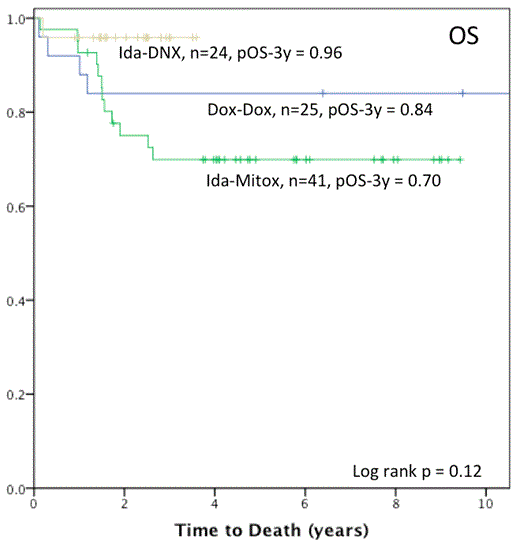Abstract
Background. The core-binding factor AMLs, t(8;21)(q22;q22), AML1-ETO or RUNX1-RUNX1T1 and inv(16)(p13q22), CBFB–MYH11, are considered as favorable risk factors in AML with superior event-free survival (EFS) and overall survival (OS). However, within the AML protocol from the Nordic society of pediatric hematology/oncology (NOPHO) from 2004 we observed a decrease in EFS for t(8;21) AML.
Material. We analyzed all children with t(8;21) or inv(16) treated on NOPHO-AML 93 and NOPHO-AML 2004 from Denmark, Finland, Iceland, Norway, and Sweden from 1993 to 2013 and patients from countries later joining the NOPHO-AML 2004 protocol; Estonia (2004), Hong Kong (2007), Belgium and the Netherlands (2010). The choice of anthracycline during induction changed from two courses including doxorubicin (75 mg/m2 in each course), Dox-Dox, in the NOPHO-AML 93 to idarubicin (36 mg/m2) and mitoxantrone (30 mg/m2), Ida-Mitox, in NOPHO-AML 04. After the observation of a decrease in EFS in patients with t(8;21) in late 2010 it was recommended to give fludarabine, cytarabine, and DaunoXome (liposomal daunorubicin 180 mg/m2) as second induction to patients with t(8;21); Ida-DNX.
Results. From 1993 to 2013 a total of 90 children, median age 9.1 years range 1-16, with t(8;21) AML were treated with Dox-Dox (n=25), Ida-Mitox (n=41), and Ida-DNX (n=24). Hematopoietic stem cell transplantation was given to 10 patients (11%), mostly with sibling donors in the NOPHO-AML 93 protocol (n=7). A reduction of the 3-year EFS was noted in patients treated with Ida-Mitox (41%) compared with Dox-Dox (64%). Those treated with Ida-DNX had significantly higher 3-year EFS of 87% (Figure). The events in t(8;21) AML on Ida-Mitox were relapses (n=20), death in CR1 (n=2), and secondary malignancy (n=2). The salvage rate for relapsed t(8;21) patients remained high and the overall favorable OS did not change significantly (Figure). From 1993 to 2013 a total of 58 children with inv(16) AML were treated with Dox-Dox (n=18) and Ida-Mitox (n=40). No significant changes in EFS (72% vs. 65%) or OS (89% vs. 79%) were observed for patients with inv(16).
Conclusion. Despite the overall favorable survival in t(8;21) the present study suggests that the choice of anthracycline during induction may be of major importance for the EFS in t(8;21) AML. Idarubicin and mitoxantrone during induction was associated with an inferior EFS compared with doxorubicin in t(8;21) AML. DaunoXome combined with fludarabine and cytarabine seemed to be particular effective during induction therapy in t(8;21) AML.
No relevant conflicts of interest to declare.
Author notes
Asterisk with author names denotes non-ASH members.



